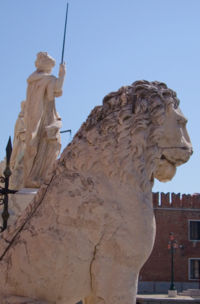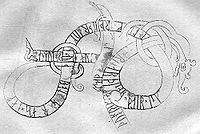
Piraeus Lion
Encyclopedia

Venetian Arsenal
The Venetian Arsenal was a complex of state-owned shipyards and armories clustered together in Venice in northern Italy. It was responsible for the bulk of Venice's naval power during the middle part of the second millennium AD...
, where it was displayed as a symbol of Venice's patron saint, Saint Mark. It was originally located in Piraeus
Piraeus
Piraeus is a city in the region of Attica, Greece. Piraeus is located within the Athens Urban Area, 12 km southwest from its city center , and lies along the east coast of the Saronic Gulf....
, the ancient harbour of Athens
Athens
Athens , is the capital and largest city of Greece. Athens dominates the Attica region and is one of the world's oldest cities, as its recorded history spans around 3,400 years. Classical Athens was a powerful city-state...
. It was looted by Venetian naval commander Francesco Morosini
Francesco Morosini
Francesco Morosini was the Doge of Venice from 1688 to 1694, at the height of the Great Turkish War...
in 1687 as plunder taken in the Great Turkish War
Great Turkish War
The Great Turkish War refers to a series of conflicts between the Ottoman Empire and contemporary European powers, then joined into a Holy League, during the second half of the 17th century.-1667–1683:...
against the Ottoman Empire
Ottoman Empire
The Ottoman EmpireIt was usually referred to as the "Ottoman Empire", the "Turkish Empire", the "Ottoman Caliphate" or more commonly "Turkey" by its contemporaries...
, during which the Venetians besieged Athens and Morosini's cannons caused damage to the Parthenon
Parthenon
The Parthenon is a temple on the Athenian Acropolis, Greece, dedicated to the Greek goddess Athena, whom the people of Athens considered their virgin patron. Its construction began in 447 BC when the Athenian Empire was at the height of its power. It was completed in 438 BC, although...
only matched by his subsequent looting. Copies of the statue can also be seen at the Piraeus Archaeological Museum and the Swedish Museum of National Antiquities
Swedish Museum of National Antiquities
Swedish Museum of National Antiquities is a museum located in Stockholm, Sweden that covers Swedish cultural history and art from the Stone Age to the 16th century...
in Stockholm
Stockholm
Stockholm is the capital and the largest city of Sweden and constitutes the most populated urban area in Scandinavia. Stockholm is the most populous city in Sweden, with a population of 851,155 in the municipality , 1.37 million in the urban area , and around 2.1 million in the metropolitan area...
.
The lion was a famous landmark in Piraeus, having stood there since the 1st or 2nd century AD. Its prominence was such that the port was given the name Porto Leone ("Lion Port") by the Italians. It is depicted in a sitting pose, with a hollow throat and the mark of a pipe (now lost) running down its back; this suggests that it was originally used as a fountain. This is consistent with the description of the statue from the 1670s, which said that water flowed from the lion's mouth into a cistern at its feet.
The statue, which is made of white marble
Marble
Marble is a metamorphic rock composed of recrystallized carbonate minerals, most commonly calcite or dolomite.Geologists use the term "marble" to refer to metamorphosed limestone; however stonemasons use the term more broadly to encompass unmetamorphosed limestone.Marble is commonly used for...
and stands some 3 m (9 ft.) high, is particularly noteworthy for having been defaced some time in the second half of the 11th century by Scandinavians who carved two lengthy runic
Runic alphabet
The runic alphabets are a set of related alphabets using letters known as runes to write various Germanic languages before the adoption of the Latin alphabet and for specialized purposes thereafter...
inscriptions into the shoulders and flanks of the lion. The runes are carved in the shape of an elaborate lindworm
Lindworm
Lindworm in British heraldry, is a technical term for a wingless bipedal dragon often with a venomous bite.-Etymology:In modern Scandinavian languages, the cognate lindorm can refer to any 'serpent' or monstrous...
dragon-headed scroll
Scroll
A scroll is a roll of parchment, papyrus, or paper, which has been drawn or written upon.Scroll may also refer to:*Scroll , the decoratively curved end of the pegbox of string instruments such as violins...
, in much the same style as on runestones in Scandinavia
Scandinavia
Scandinavia is a cultural, historical and ethno-linguistic region in northern Europe that includes the three kingdoms of Denmark, Norway and Sweden, characterized by their common ethno-cultural heritage and language. Modern Norway and Sweden proper are situated on the Scandinavian Peninsula,...
. The carvers of the runes were almost certainly Varangians
Varangians
The Varangians or Varyags , sometimes referred to as Variagians, were people from the Baltic region, most often associated with Vikings, who from the 9th to 11th centuries ventured eastwards and southwards along the rivers of Eastern Europe, through what is now Russia, Belarus and Ukraine.According...
, Scandinavian mercenaries in the service of the Byzantine Emperor.
Inscriptions and translations


Johan David Åkerblad
Johan David Åkerblad was a Swedish diplomat and orientalist, a student of Silvestre de Sacy. Sacy's investigation of the Rosetta Stone did not give any result and Åkerblad took on his work in 1802 and managed to identify all proper names in the demotic text in just two months...
identified them at the end of the 18th century. They are in the shape of a lindworm
Lindworm
Lindworm in British heraldry, is a technical term for a wingless bipedal dragon often with a venomous bite.-Etymology:In modern Scandinavian languages, the cognate lindorm can refer to any 'serpent' or monstrous...
(a flightless dragon with serpentine body and two or no legs) and were first translated in the mid-19th century by Carl Christian Rafn
Carl Christian Rafn
Carl Christian Rafn was a Danish historian, translator and antiquarian. His scholarship to a large extent focused on translation of Old Norse literature and related Northern European ancient history...
, the Secretary of the Kongelige Nordiske Oldskrift-Selskab (Royal Society of Nordic Antiquaries). The inscriptions are heavily eroded due to weathering and air pollution, making many of the individual runes barely legible. This has required translators to reconstruct some of the runes, filling in the blanks to determine what words they represented.
There have been several attempts to decipher and translate the text. Below follow Hrafn's early attempt (1854) and Eric Brate's attempt (1914), which is considered to be the most successful one.
Hrafn's translation
Rafn's attempt is as follows, with the legible letters shown in bold and the reconstructed ones unbolded:Right side of the lion:
- ASMUDR : HJU : RUNAR : ÞISAR : ÞAIR : ISKIR : AUK: ÞURLIFR : ÞURÞR : AUK : IVAR : AT : BON : HARADS : HAFA : ÞUAT : GRIKIAR : UF : HUGSAÞU : AUK : BANAÞU :
- Asmund cut these runes with Asgeir and Thorleif, Thord and Ivar, at the request of Harold the Tall, though the Greeks considered about and forbade it.
Left side of the lion:
- HAKUN : VAN: ÞIR : ULFR : AUK : ASMUDR : AUK : AURN : HAFN : ÞESA : ÞIR : MEN : LAGÞU : A : UK : HARADR : HAFI : UF IABUTA : UPRARSTAR : VEGNA : GRIKIAÞIÞS : VARÞ : DALKR : NAUÞUGR : I : FIARI : LAÞUM : EGIL : VAR : I : FARU : MIÞ : RAGNARR : TIL : RUMANIU . . . . AUK : ARMENIU :
- Hakon with Ulf and Asmund and Örn conquered this port. These men and Harold Hafi imposed a heavy fine on account of the revolt of the Greek people. Dalk is detained captive in far lands. Egil is gone on an expedition with Ragnar into RomaniaByzantine EmpireThe Byzantine Empire was the Eastern Roman Empire during the periods of Late Antiquity and the Middle Ages, centred on the capital of Constantinople. Known simply as the Roman Empire or Romania to its inhabitants and neighbours, the Empire was the direct continuation of the Ancient Roman State...
and ArmeniaArmeniaArmenia , officially the Republic of Armenia , is a landlocked mountainous country in the Caucasus region of Eurasia...
.
- Hakon with Ulf and Asmund and Örn conquered this port. These men and Harold Hafi imposed a heavy fine on account of the revolt of the Greek people. Dalk is detained captive in far lands. Egil is gone on an expedition with Ragnar into Romania
Some have tried to trace Harald Hardrade's name on the inscription, but the time it was carved does not coincide with his time in the service of the emperor.
Erik Brate's translation
Erik Brate's interpretation from 1914 is considered to be the most successful one.
|
Roslagen Roslagen is the name of the coastal areas of Uppland province in Sweden, which also constitutes the northern part of the Stockholm archipelago.... . [N. N.] son of [N. N.] |
See also
- Berezan' RunestoneBerezan' RunestoneThe Berezan' Runestone was discovered in 1905 by Ernst von Stern, professor at Odessa, on Berezan' Island where the Dnieper River meets the Black Sea. It is wide, high and thick, and it is presently located in the museum of Odessa. It was made by a Varangian trader named Grani in memory of...
- Greece RunestonesGreece RunestonesThe Greece runestones are about 30 runestones containing information related to voyages made by Norsemen to the Eastern Roman Empire. They were made during the Viking Age until about 1100 and were engraved in the Old Norse language with Scandinavian runes...
- Italy RunestonesItaly RunestonesThe Italy Runestones are three or four Varangian Runestones from 11th century Sweden that talk of warriors who died in Langbarðaland , the Old Norse name for Italy...
- Runic inscriptions in Hagia SophiaRunic inscriptions in Hagia SophiaThere are at least two runic inscriptions in Hagia Sophias marble parapets. They may have been engraved by members of the Varangian Guard in Constantinople in the Viking Age.-The Halfdan inscription:...

